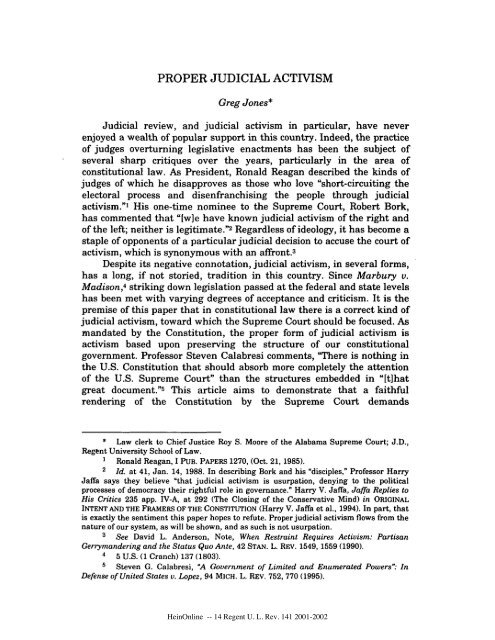Judicial ReEngineering
Judicial ReEngineering
Judicial ReEngineering
Create successful ePaper yourself
Turn your PDF publications into a flip-book with our unique Google optimized e-Paper software.
PROPER JUDICIAL ACTIVISM<br />
Greg Jones*<br />
<strong>Judicial</strong> review, and judicial activism in particular, have never<br />
enjoyed a wealth of popular support in this country. Indeed, the practice<br />
of judges overturning legislative enactments has been the subject of<br />
several sharp critiques over the years, particularly in the area of<br />
constitutional law. As President, Ronald Reagan described the kinds of<br />
judges of which he disapproves as those who love "short-circuiting the<br />
electoral process and disenfranchising the people through judicial<br />
activism." 1 His one-time nominee to the Supreme Court, Robert Bork,<br />
has commented that "[wle have known judicial activism of the right and<br />
of the left; neither is legitimate." 2 Regardless of ideology, it has become a<br />
staple of opponents of a particular judicial decision to accuse the court of<br />
activism, which is synonymous with an affront. 3<br />
Despite its negative connotation, judicial activism, in several forms,<br />
has a long, if not storied, tradition in this country. Since Marbury v.<br />
Madison, 4 striking down legislation passed at the federal and state levels<br />
has been met with varying degrees of acceptance and criticism. It is the<br />
premise of this paper that in constitutional law there is a correct kind of<br />
judicial activism, toward which the Supreme Court should be focused. As<br />
mandated by the Constitution, the proper form of judicial activism is<br />
activism based upon preserving the structure of our constitutional<br />
government. Professor Steven Calabresi comments, "There is nothing in<br />
the U.S. Constitution that should absorb more completely the attention<br />
of the U.S. Supreme Court" than the structures embedded in "[t]hat<br />
great document." s This article aims to demonstrate that a faithful<br />
rendering of the Constitution by the Supreme Court demands<br />
* Law clerk to Chief Justice Roy S. Moore of the Alabama Supreme Court; J.D.,<br />
Regent University School of Law.<br />
1 Ronald Reagan, I PUB. PAPERS 1270, (Oct. 21, 1985).<br />
2 Id. at 41, Jan. 14, 1988. In describing Bork and his "disciples," Professor Harry<br />
Jaffa says they believe "that judicial activism is usurpation, denying to the political<br />
processes of democracy their rightful role in governance." Harry V. Jaffa, Jaffa Replies to<br />
His Critics 235 app. IV-A, at 292 (The Closing of the Conservative Mind) in ORIGINAL<br />
INTENT AND THE FRAMERS OF THE CONSTITUTION (Harry V. Jaffa et al., 1994). In part, that<br />
is exactly the sentiment this paper hopes to refute. Proper judicial activism flows from the<br />
nature of our system, as will be shown, and as such is not usurpation.<br />
3 See David L. Anderson, Note, When Restraint Requires Activism: Partisan<br />
Gerrymandering and the Status Quo Ante, 42 STAN. L. REV. 1549, 1559 (1990).<br />
4 5 U.S. (1 Cranch) 137 (1803).<br />
5 Steven G. Calabresi, "A Government of Limited and Enumerated Powers": In<br />
Defense of United States v. Lopez, 94 MIcH. L. REV. 752, 770 (1995).<br />
HeinOnline -- 14 Regent U. L. Rev. 141 2001-2002

















